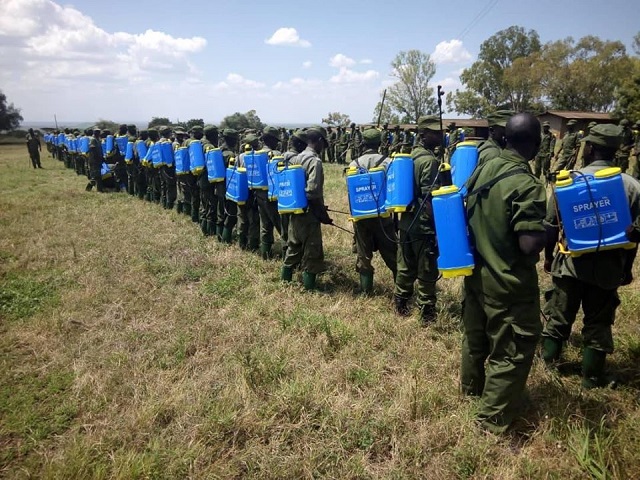
Kampala, Uganda | THE INDEPENDENT | Public Health and environmental experts have said that the use of chemicals should be done with caution to avoid associated dangers in efforts to contain locusts’ invasion in Uganda.
Dr Richard K. Mugambe, a lecturer in the Department of Disease Control and Environmental Health at Makerere University School of Public Health says there are possibilities of having some effects if caution is not taken while spraying the locusts.
Following the invasion of locusts in the Karamoja region on Sunday, government has since announced and dispatched several cartons of chemicals for use to contain them.
The locusts are reported to have entered Uganda through the northwest Pokot area through Amudat district and several other districts in Karamoja sub-region.
Stephen Tibeijuka Byantwale, the Commissioner of Crop Protection at the Ministry of Agriculture, Animal Industry and Fisheries, says government will use three chemicals against the desert locusts.
They are Fenitrothion 96 percent low volume formulation, Malathion, and Pyrethroid insecticides.
Government started dispatching the chemicals for use in the already infested northern Uganda districts on Monday with a dispatch of some 18,000 litres of pesticides to Amudat district in Karamoja sub-region. This is to aid the aerial spraying and manual pump spraying.
Dr Mugambe explains that the chemicals are Organophosphates with low toxicity and less harmful to both human life and environment. With an exception of Fenitrothion 96 percent low volume formulation, which according to Dr Mugambe endangers bees, the rest of the chemicals are okay, having been approved by the World Health Organisation (WHO).
The management of hazardous chemicals and biodiversity offsets in pest control is regulated through the 2019 National Environmental Management Authority (NEMA) Act.
The law provides for an environmental impact assessment and approval by the authority especially if chemical spraying for vector control is to be done.
Arnold Waiswa Ayazika, the NEMA director, Environmental Monitoring and Compliance says the law provides exemptions of environmental impact assessment for emergencies situations such as one of Locusts.
Ayazika says that the NEMA has established a multi-sectoral team which is to be dispatched this week in the locust invasion areas.
He contends that beyond the suppressing of the locusts, NEMA is interested in monitoring the potential impact of chemicals on water sources, food crops and or any other non-target organisms.
Tibeijuka, who also doubles as the head of the Inter-Ministerial Task Force set up to fight Locusts says government has put in place measures to ensure proper use of the chemicals not to harm the environment.
Dr Mugambe argues that the sprayers should be carefully trained on the issues related to the chemicals that going to be used, the impact, the caution, the procedures to undertake while spraying among others.
He warned locals against procuring their own chemicals to spray in their gardens. Dr Mugambe also wants government to expedite processes of sensitization of the locals in terms of precautionary measures to undertake during the spraying operations.
This is not the first time Uganda is experiencing Locust infestation. Uganda last experienced a major locust invasion in 1961, with immense damage on crops which resulted in acute hunger.
Antonio Querido, the Food Agricultural Organisation (FAO) Uganda Country Representative says the insecticides are less harmful to the environment but quite effective in response.
According to Querido, another alternative to these synthetic chemicals being used is bi0pesticides, and growth retardant pesticides, although he argues they take a longer time to be effective.
According to research published by University of Hertfordshire, a public university in Hertfordshire, United Kingdom shows that Fenitrothion is no longer certified for use in the European Union (EU) having been banned in 2009.
While the same chemical is reported to be highly soluble in many organic solvents and is volatile, research shows it is highly toxic to birds, aquatic invertebrates and honeybees, and moderately toxic to fish, algae and earthworms.
Also highly toxic to bees and other beneficial insects, some fish, and other aquatic life is Malathion, which according to a research released by Oregon State University (OSU is moderately toxic to other fish and birds, but is considered low in toxicity to mammals.
Government plans to spray Pyrethroid Insecticides to nymphs since the migratory insects are mating as they move and therefore multiplying. The insecticide targets to kill the young locusts before they mature to fly.
But studies recommend keeping pets, and children indoors during and for about 30 minutes after spraying reduce exposure, as pyrethroids are most likely to be present in breast milk and, and consequently, breastfeeding may be the starting point of their accumulation in tissue.
Oral exposure to Pyrethroid insecticides according to research published by the National Center for Biotechnology Information (NCBI) may cause dizziness and headaches, anorexia, fatigue, nausea, vomiting, pulmonary oedema, convulsions, coma and even death. NCBI is part of the United States National Library of Medicine, a branch of the National Institutes of Health.
******
URN
 The Independent Uganda: You get the Truth we Pay the Price
The Independent Uganda: You get the Truth we Pay the Price


